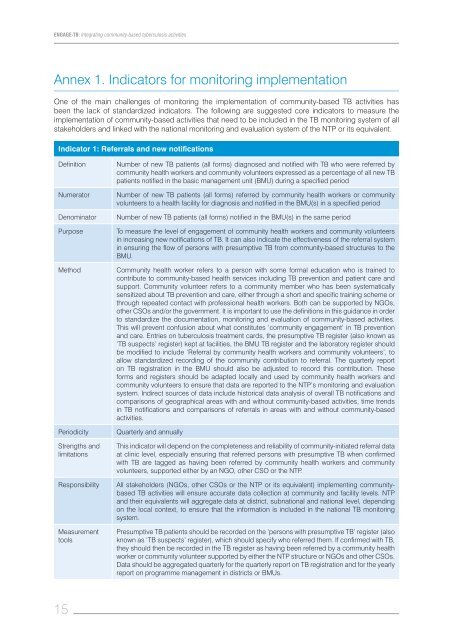ENGAGE-TB: Operational Guidance - World Health Organization
ENGAGE-TB: Operational Guidance - World Health Organization
ENGAGE-TB: Operational Guidance - World Health Organization
You also want an ePaper? Increase the reach of your titles
YUMPU automatically turns print PDFs into web optimized ePapers that Google loves.
<strong>ENGAGE</strong>-<strong>TB</strong>: Integrating community-based tuberculosis activities<br />
Annex 1. Indicators for monitoring implementation<br />
One of the main challenges of monitoring the implementation of community-based <strong>TB</strong> activities has<br />
been the lack of standardized indicators. The following are suggested core indicators to measure the<br />
implementation of community-based activities that need to be included in the <strong>TB</strong> monitoring system of all<br />
stakeholders and linked with the national monitoring and evaluation system of the NTP or its equivalent.<br />
Indicator 1: Referrals and new notifications<br />
Definition Number of new <strong>TB</strong> patients (all forms) diagnosed and notified with <strong>TB</strong> who were referred by<br />
community health workers and community volunteers expressed as a percentage of all new <strong>TB</strong><br />
patients notified in the basic management unit (BMU) during a specified period<br />
Numerator Number of new <strong>TB</strong> patients (all forms) referred by community health workers or community<br />
volunteers to a health facility for diagnosis and notified in the BMU(s) in a specified period<br />
Denominator Number of new <strong>TB</strong> patients (all forms) notified in the BMU(s) in the same period<br />
Purpose To measure the level of engagement of community health workers and community volunteers<br />
in increasing new notifications of <strong>TB</strong>. It can also indicate the effectiveness of the referral system<br />
in ensuring the flow of persons with presumptive <strong>TB</strong> from community-based structures to the<br />
BMU.<br />
Method Community health worker refers to a person with some formal education who is trained to<br />
contribute to community-based health services including <strong>TB</strong> prevention and patient care and<br />
support. Community volunteer refers to a community member who has been systematically<br />
sensitized about <strong>TB</strong> prevention and care, either through a short and specific training scheme or<br />
through repeated contact with professional health workers. Both can be supported by NGOs,<br />
other CSOs and/or the government. It is important to use the definitions in this guidance in order<br />
to standardize the documentation, monitoring and evaluation of community-based activities.<br />
This will prevent confusion about what constitutes ‘community engagement’ in <strong>TB</strong> prevention<br />
and care. Entries on tuberculosis treatment cards, the presumptive <strong>TB</strong> register (also known as<br />
‘<strong>TB</strong> suspects’ register) kept at facilities, the BMU <strong>TB</strong> register and the laboratory register should<br />
be modified to include ‘Referral by community health workers and community volunteers’, to<br />
allow standardized recording of the community contribution to referral. The quarterly report<br />
on <strong>TB</strong> registration in the BMU should also be adjusted to record this contribution. These<br />
forms and registers should be adapted locally and used by community health workers and<br />
community volunteers to ensure that data are reported to the NTP’s monitoring and evaluation<br />
system. Indirect sources of data include historical data analysis of overall <strong>TB</strong> notifications and<br />
comparisons of geographical areas with and without community-based activities, time trends<br />
in <strong>TB</strong> notifications and comparisons of referrals in areas with and without community-based<br />
activities.<br />
Periodicity Quarterly and annually<br />
Strengths and<br />
limitations<br />
15<br />
This indicator will depend on the completeness and reliability of community-initiated referral data<br />
at clinic level, especially ensuring that referred persons with presumptive <strong>TB</strong> when confirmed<br />
with <strong>TB</strong> are tagged as having been referred by community health workers and community<br />
volunteers, supported either by an NGO, other CSO or the NTP.<br />
Responsibility All stakeholders (NGOs, other CSOs or the NTP or its equivalent) implementing communitybased<br />
<strong>TB</strong> activities will ensure accurate data collection at community and facility levels. NTP<br />
and their equivalents will aggregate data at district, subnational and national level, depending<br />
on the local context, to ensure that the information is included in the national <strong>TB</strong> monitoring<br />
system.<br />
Measurement<br />
tools<br />
Presumptive <strong>TB</strong> patients should be recorded on the ‘persons with presumptive <strong>TB</strong>’ register (also<br />
known as ‘<strong>TB</strong> suspects’ register), which should specify who referred them. If confirmed with <strong>TB</strong>,<br />
they should then be recorded in the <strong>TB</strong> register as having been referred by a community health<br />
worker or community volunteer supported by either the NTP structure or NGOs and other CSOs.<br />
Data should be aggregated quarterly for the quarterly report on <strong>TB</strong> registration and for the yearly<br />
report on programme management in districts or BMUs.

















